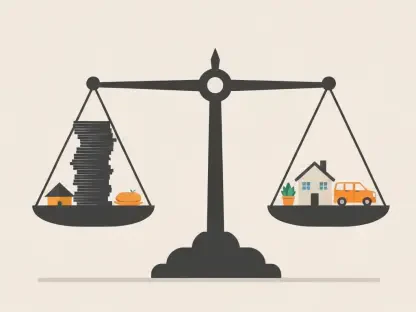The enduring battle against financial crime, including pervasive issues like money laundering and fraud, has been a persistent challenge for financial institutions and regulatory bodies alike. Traditional Anti-Money Laundering (AML) systems, burdened with outdated technology and labor-intensive processes, are struggling to keep up with increasingly sophisticated criminals. However, the advent of blockchain technology marks the dawn of a transformative era in this ongoing struggle.
Transformation of AML Compliance
Traditional AML Systems: An Overview
Current AML systems are designed to detect and prevent suspicious activities within financial institutions. However, these conventional systems often fall short, plagued by inefficiencies such as slow manual processes and vulnerability to manipulation. As a result, financial institutions continue to spend exorbitant amounts to maintain compliance, all while criminals exploit these systemic loopholes.
AML systems today often involve cumbersome processes that require significant human intervention, opening the door to both human error and exploitation by savvy criminals. The decentralized nature of modern financial transactions further complicates the scenario, providing numerous avenues for illicit funds to be moved and hidden. As financial crimes evolve, so too must the systems put in place to detect and prevent them. This scenario necessitates a rethinking of traditional AML frameworks, which are increasingly inadequate against emerging threats.
To address these shortcomings, there is an urgent need for robust, transparent solutions capable of real-time monitoring. Many institutions are beginning to acknowledge the necessity for an upgrade to keep pace with the evolving nature of financial crimes. The introduction of new technology into AML processes holds promise for more effective and efficient compliance, reducing both costs and vulnerabilities. This acknowledgment has led to a growing interest in blockchain technology as a viable and forward-thinking solution.
Blockchain as a Game Changer
Blockchain technology presents a revolutionary shift in this space. By creating an immutable ledger, where every transaction is permanently recorded, encrypted, and time-stamped, blockchain ensures unmatched transparency and security. These characteristics are crucial for effective AML compliance, enabling the real-time tracking and instant detection of suspicious activities.
One of the standout features of blockchain is its ability to provide tamper-proof records. This immutable ledger means that every transaction is accessible for verification and virtually impossible to manipulate, offering unprecedented transparency. In practice, this means that financial institutions can maintain a clear and accessible history of transactions, making it significantly easier to trace and identify illicit activity. This high level of transparency and security shifts the power balance in favor of those seeking to combat financial crimes.
The security provided by blockchain comes from its distributed nature and the cryptographic principles underlying each transaction. Every transaction is recorded in a block that is linked to the preceding block, contributing to a chain of transactions that is both transparent and immutable. This technological foundation reduces the chances of fraudulent activity going undetected. Moreover, it ensures that once data is recorded, it cannot be altered without widespread consensus, further thwarting potential criminal activities.
Breaking Down Blockchain Advantages
Automation and Smart Contracts
Beyond mere transaction recording, blockchain leverages smart contracts to automate compliance efficiently. By embedding AML rules into these contracts, transactions that fail to meet compliance standards are automatically blocked, significantly reducing human error and expediting the enforcement of regulations. This automation reduces the burden on human auditors and ensures that compliance is maintained consistently and without delay.
Smart contracts can be programmed to follow specific criteria, acting as gatekeepers for the legitimacy of transactions. When a transaction is initiated, the smart contract evaluates it against pre-set AML rules. If a transaction does not comply with these rules, it is rejected or flagged for further review, ensuring that only compliant transactions are processed. This capability greatly enhances the efficiency and effectiveness of AML efforts, transforming what was once a slow, manual process into a swift, automated one.
The automation mechanism of smart contracts ensures that any abnormal transaction instantly triggers alarms, necessitating immediate scrutiny and action by concerned authorities, thereby mitigating fraud risks. These automatic alerts provide real-time notifications, enabling financial institutions to react swiftly to potential threats. This proactive approach is a significant advancement over traditional methods, which often detect suspicious activity only after the fact. By catching anomalies as they happen, blockchain significantly enhances the capability to combat financial crimes.
Tools for Enhanced Monitoring
Contrary to the misconception that blockchain is a haven for illicit activities, the inherent transparency of blockchain technology makes it an effective tool for tracking financial crime. With the aid of advanced tools like Chainalysis and CipherTrace, investigators can monitor and trace crypto transactions in real-time with unparalleled speed and accuracy. These tools analyze blockchain data to identify patterns and connections that may indicate fraudulent activities, providing valuable insights for both regulatory bodies and financial institutions.
Chainalysis, for instance, uses sophisticated algorithms to trace the origin and destination of cryptocurrencies, linking them to known illicit entities when applicable. By mapping out networks of transactions, these tools can identify clusters of activity that might indicate money laundering or other financial crimes. This capability offers a level of traceability previously unavailable in traditional finance, making it simpler to track the flow of cryptocurrency and identify nefarious activities.
These blockchain analytics tools are now indispensable for regulatory bodies and law enforcement agencies, providing the means to pursue and dismantle cross-border financial crimes that were previously difficult to trace. The data gathered can be used to inform investigations and support prosecutions, making it a powerful weapon in the fight against financial crime. This evolution into a more transparent and traceable financial ecosystem represents a significant step forward in global AML efforts.
Navigating DeFi Challenges
The Rise of DeFi
The emergence of Decentralized Finance (DeFi) brings new challenges to AML compliance. DeFi platforms facilitate borderless and often anonymous transactions, offering financial services without traditional oversight. This lack of Know Your Customer (KYC) protocols makes these platforms attractive for laundering money. Without these regulatory safeguards, DeFi becomes a fertile ground for financial crimes, presenting new hurdles for both regulators and institutions.
To address these challenges, regulators and innovators are developing advanced tools to oversee and monitor DeFi transactions. Among the proposed solutions are self-regulating protocols that ensure compliance is maintained without direct intervention. These protocols can be designed to enforce KYC and AML standards, even in a decentralized context. Additionally, AI-driven monitoring systems can analyze vast amounts of transactional data in real-time, identifying suspicious behavior and flagging it for further investigation.
Self-regulating protocols, AI-driven monitoring, and decentralized identity verification frameworks are among the proposed solutions to ensure DeFi remains compliant with AML regulations. By integrating these technologies, DeFi platforms can enhance their transparency and security, making it more difficult for criminals to exploit these services. These innovations represent an evolving approach to AML compliance, one that adapts to the unique challenges posed by decentralized financial ecosystems.
Innovations and Future Trends
Despite these hurdles, blockchain’s core transparency continues to provide viable solutions. By fostering cooperation between regulators and DeFi platforms, the development of sophisticated monitoring tools ensures that financial services can evolve while maintaining strict compliance standards. This collaborative approach aims to create a balanced environment where both innovation and regulation coexist, allowing the benefits of DeFi to be enjoyed without compromising security.
The ongoing evolution of AML in the DeFi space indicates a future where regulatory frameworks are robust enough to handle the unique challenges posed by decentralized platforms. These advancements promise a future where DeFi can continue to grow and innovate while adhering to necessary regulations. By integrating new technologies and methodologies, the financial industry can ensure that the benefits of DeFi are not overshadowed by its risks.
In a rapidly changing financial landscape, the ability to adapt and innovate is crucial. This includes not only the adoption of new technologies but also the development of new regulations and standards. As the financial ecosystem continues to evolve, regulators and institutions must work together to ensure that AML efforts remain effective. This collaboration will be key to maintaining the integrity and security of financial services in the face of emerging threats.
Government and Global Standards
Adoption by Governments
Governments across the world are beginning to recognize the transformative potential of blockchain technology to enhance AML efforts. Countries like Switzerland, Singapore, and the United States are integrating blockchain into their financial monitoring systems, utilizing AI-powered analytics to combat financial crime on a global scale. These efforts underscore a growing international consensus on the value of blockchain in modernizing financial regulation and oversight.
Such initiatives highlight the growing confidence in blockchain’s potential to streamline and fortify financial oversight mechanisms. By adopting blockchain, governments can enhance their ability to detect and prevent financial crimes, ensuring a more secure financial system. The use of AI-powered analytics further enhances the capabilities of these systems, providing deep insights and real-time monitoring.
The integration of blockchain technology into government financial oversight systems marks a significant shift towards more advanced and effective AML efforts. By leveraging the unique properties of blockchain, such as transparency, immutability, and real-time tracking, governments can create more robust and reliable monitoring systems. This innovation not only improves the detection and prevention of financial crimes but also sets a new standard for regulatory practices worldwide.
Global Standards and Compliance
The unending battle against financial crime, which includes major issues like money laundering and fraud, has been a persistent challenge for both financial institutions and regulatory bodies. Traditional Anti-Money Laundering (AML) systems, bogged down by outdated technology and labor-intensive methods, are finding it difficult to keep pace with increasingly sophisticated criminals. These systems often lack the agility and advanced analytics needed to detect and prevent modern financial crimes effectively. However, the emergence of blockchain technology signals a revolutionary shift in this ongoing fight. Blockchain, with its decentralized ledger and transparency, offers a robust solution to many of the limitations faced by traditional AML systems. It enhances the ability of institutions to track and verify transactions in real-time, thereby drastically reducing the chances of fraudulent activities slipping through the cracks. This innovation not only promises more efficient and effective financial crime prevention but also ushers in a new era of trust and traceability within the financial sector.









